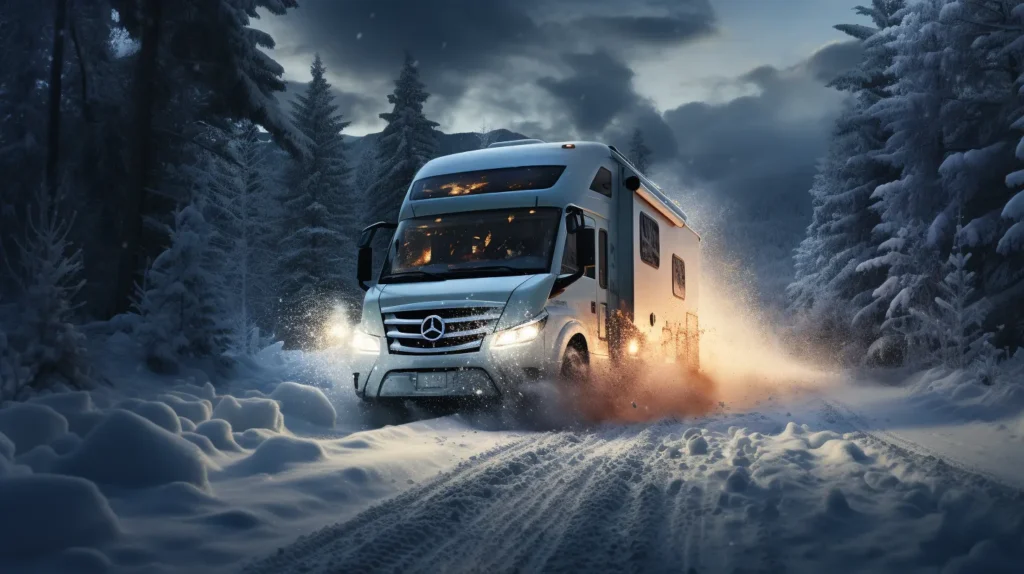Navigating an RV through snow and ice demands careful preparation and a keen understanding of winter driving techniques. As temperatures drop and road conditions become hazardous, it’s crucial to equip yourself with the necessary knowledge and resources to ensure a safe and smooth journey. In this guide, we will explore essential tips for driving an RV in snow and ice, covering topics such as preparing your vehicle for winter travel, mastering snow and ice driving techniques, and equipping your RV with the right tires and chains. Additionally, we will delve into navigating icy roads and treacherous terrain, as well as emergency preparedness for winter RV travel. Whether you’re a seasoned traveler or a novice, these insights will help you navigate winter roads with confidence and caution.
Preparing Your RV for Winter Driving
When driving an RV in snow and ice, it is crucial to prepare your vehicle for winter conditions to ensure safety and optimal performance. Start by checking your RV’s tires to ensure they have sufficient tread depth and are properly inflated. Consider using snow chains or investing in snow tires for enhanced traction. It is also important to check the RV’s antifreeze levels and ensure that the engine is in good working condition. Additionally, inspect the windshield wipers and consider using winter-grade windshield washer fluid to improve visibility. Furthermore, pack essential winter supplies such as a shovel, ice scraper, and emergency kit. By taking these preparatory measures, you can significantly reduce the risk of accidents and ensure a smoother driving experience in snow and ice.
Understanding snow and ice driving techniques is essential for safe winter travel.
Understanding Snow and Ice Driving Techniques
To navigate safely in snow and ice, it is essential to understand and employ specific driving techniques that mitigate the challenges posed by winter weather conditions. When driving in snowy or icy conditions, it’s crucial to reduce speed and increase following distance to allow for longer stopping distances. Gentle steering inputs help maintain control, while gradual acceleration and deceleration minimize the risk of skidding. It’s important to avoid sudden movements, such as sharp turns or abrupt braking, which can lead to loss of traction. Additionally, using winter tires with adequate tread depth and considering the use of tire chains in extreme conditions can significantly improve traction. Understanding these driving techniques and adapting to the changing road conditions is vital for safe and confident driving in snow and ice.
Equipping Your RV With Winter Tires and Chains
Equipping an RV with winter tires and chains is essential for ensuring optimal traction and safety when driving in snowy and icy conditions. Winter tires are specifically designed to remain flexible in cold weather, providing better grip on icy roads compared to all-season tires. When selecting winter tires for an RV, it is important to choose ones with a high-quality rubber compound and deep treads to effectively navigate through snow and slush. Additionally, installing tire chains can further enhance traction on extremely icy surfaces. It is crucial to check local regulations regarding the use of tire chains, as some areas may have specific requirements or restrictions. By equipping your RV with winter tires and chains, you can significantly improve your vehicle’s handling and stability in winter weather, reducing the risk of accidents and ensuring a safer journey.
Navigating Icy Roads and Treacherous Terrain
While driving an RV in snow and ice, it is essential to navigate icy roads and treacherous terrain with caution and preparedness. Here are some key points to consider:
Reduce Speed:
- Decrease your driving speed significantly to maintain better control and allow for longer stopping distances.
- Utilize lower gears to avoid sudden acceleration and deceleration.
- Keep a safe distance from other vehicles on the road.
Stay Informed:
- Stay updated on weather and road conditions along your route.
- Check weather forecasts and road reports before and during your journey.
- Be prepared to alter your route if necessary to avoid the most hazardous areas.
Emergency Supplies:
- Carry essential emergency supplies in your RV.
- Items such as blankets, extra clothing, non-perishable food, water, a flashlight, and a first aid kit are crucial for unexpected situations.
Emergency Preparedness for Winter RV Travel
Winter RV travel requires thorough emergency preparedness to ensure safety and readiness for unexpected situations. Before embarking on a winter RV trip, it is crucial to pack essential emergency supplies. These should include extra blankets, warm clothing, non-perishable food, water, a first-aid kit, flashlight, batteries, a portable weather radio, and a basic toolkit. Additionally, it is important to have a well-stocked emergency kit for the RV, including tire chains, a shovel, ice scraper, and sand or kitty litter for traction. It is advisable to have a backup power source, such as a portable generator, to ensure heating and electricity in case of a power outage. Familiarize yourself with emergency protocols and contacts, including roadside assistance services and local emergency services. Preparedness is key to staying safe and secure during winter RV travel.


